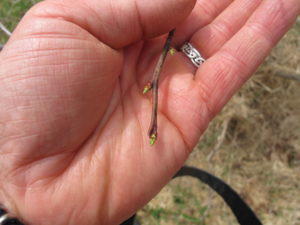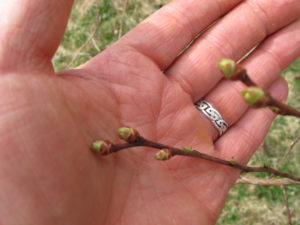How to Prune Your Blueberries
I recently spent half a day helping a friend prune her blueberries. Some rows hadn’t been tended too in a couple of years or more, and had gotten very bushy and overgrown. It is very satisfying work, knowing that bushes will produce better and be easier to pick once they have been pruned.
The first thing I did was cut out branches that had flopped over and were spread out in the walkways. It is important for both pickers and mowers to be able to go up and down the rows easily. I didn’t just cut off the ends of the intruding branches, I cut them back to their points of origin near the center of the bushes, just above the soil line. To do that, I used some nice geared loppers made by Fiskars to cut back the thick stems that were in the way. These geared loppers are 32 inches long and have a mechanical advantage built in which facilitates cutting stems up to an inch and a half without straining. The long handles meant I didn’t have to crawl into the bush to get to the base of a stem.
One note about spacing of blueberry bushes: gardeners often try to pack as many plants into a space as possible. Don’t. Crowding blueberries makes working in them more difficult. Space rows 10 feet apart at planting time. That might seem excessive, but it will be a big help later. The minimum space between plants should be 6 feet, and 8 feet is even better.
After clearing out walking space, I went down the rows with my hand pruners. I removed all dead branches. These have no fruit buds and are gray and flakey. Follow the branch back to its point of origin and cut back there. Some branches that appear dead have live side branches on them that you may want to keep.
It’s important to be able to quickly differentiate between fruit buds and leaf buds. A fruit bud is fat and somewhat round. A leaf bud is smaller, and is narrow and pointy. A branch that is dominated by leaf buds is less valuable to you than one that has lots of fruit buds, though the fruit buds also produce leaves – and a cluster of berries. If you see no fruit buds on a stem, prune it out.
What else? When deciding between two competing branches, remove the older, less vigorous branch and leave younger stems, which on blueberries often have a green or reddish color. Prune away branches that are damaged or rubbing against another branch. In general, branches should be grow out, away from the center of the bush. Branches that aim into the middle will eventually cause problems.
Blueberries sometimes develop a viral infection that causes “witches brooms.” These are masses of fine twigs growing on one branch. Remove the entire thing and put it in the trash, or burn it.
Blueberries really are easy to grow. They need full sun, which means a minimum of six hours per day. But most importantly, they need very acidic soil. Now would be a good time to collect a soil sample and send it off for testing at your state Cooperative Extension laboratory. You can download the form on-line, just Google “soil testing” and your state.
If your soil is not acidic enough, you can add elemental sulfur. This is fine for organic gardeners, too, as it is mined from the earth, not manufactured in a chemical plant. You can add sulfur anytime, just follow the directions on the package. If you use an acidic fertilizer described as good for acid-loving plants, spread that right after the bushes bloom in June.
Changing the soil pH may take you a number of years. It is better to add some this year, and again next year (and in later years) than to dump too much on at once. Your ultimate goal is a pH in the range of 4.0 to 5.0. The scale is logarithmic, meaning that 4.0 is ten times more acidic than 5.0, and a hundred times more acidic than 6.0. Seven on the scale is neutral.
Many gardeners dread pruning, perhaps because they imagine cutting off branches as like removing limbs of a person or animal. Pruning is not. It’s more like getting a haircut. It is an essential part of maintaining a good-looking, productive plant. There is no deadline for when you must stop pruning, though the later you wait, the more buds will fall off as you work on the bushes – so get started soon!
Get used to pruning, and you will have more and better fruit. And for me, spending time outdoors in early spring is much more fun than being indoors on a computer.
Henry Homeyer is the author of four gardening books and a children’s chapter book, Wobar. Check out his website at https://gardening-guy.com.





